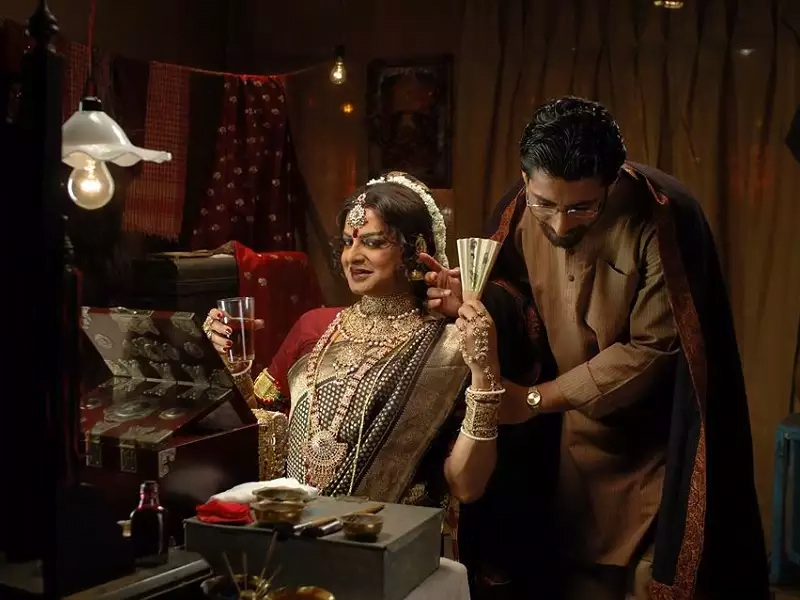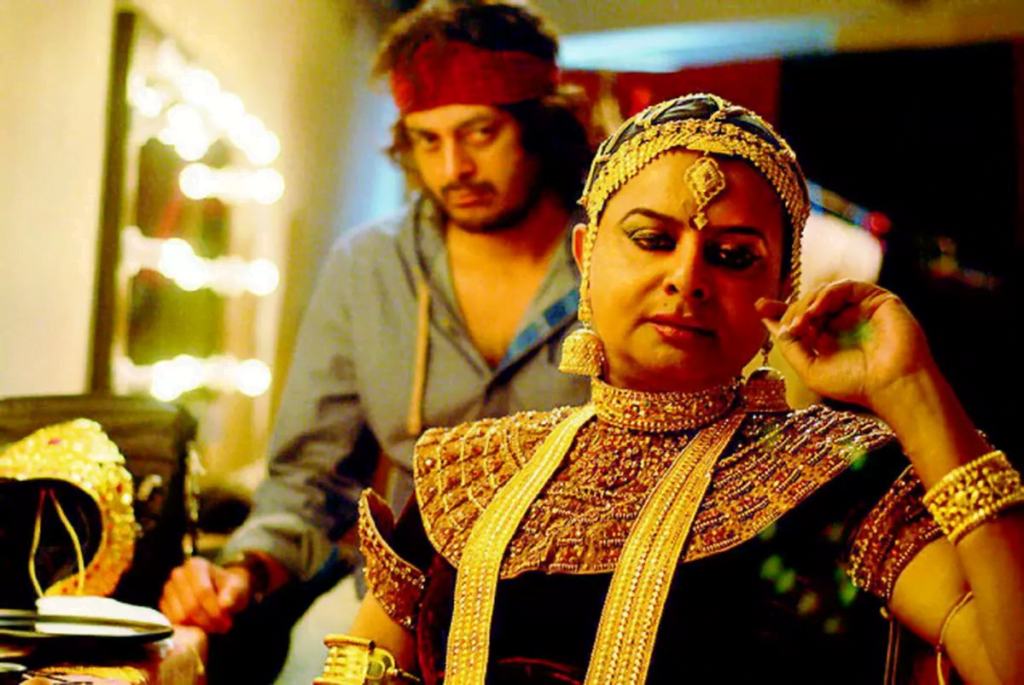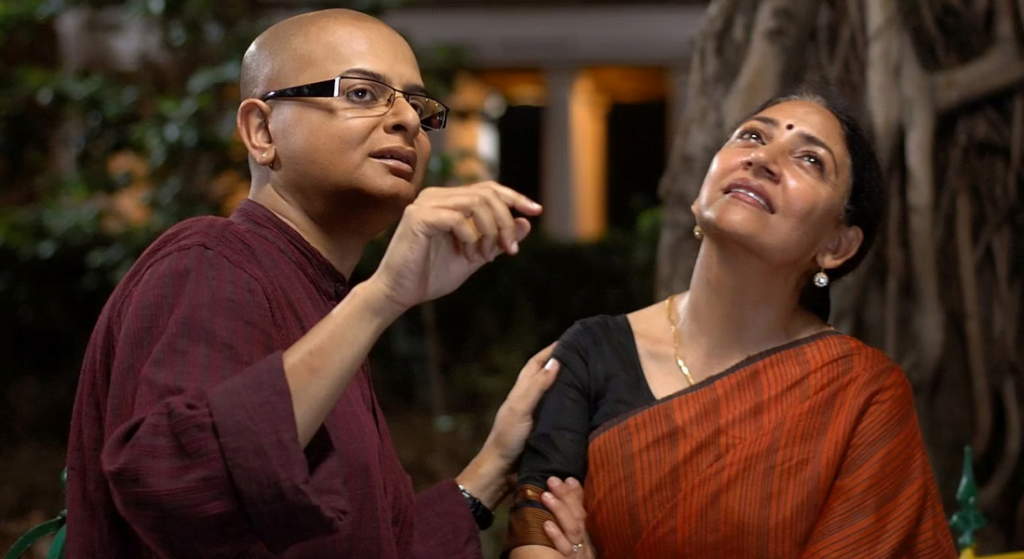Just as we were poised to enter Pride Month, the documentary Bird of Dusk was released on 30th May 2023 to observe the 10th death anniversary of Rituparno Ghosh. Directed by Sangeeta Datta, it is a look at the life and times of the visionary actor-filmmaker, who garnered national and international acclaim within a lifetime that hardly spun five decades.
The documentary begins with a scene from Arekti Premer Golpo (2010), a reference to the Bird of Dusk allusion. The character of Abhiroop (Rituparno), a documentary filmmaker is explaining to Uday (Jisshu Sengupta), an admirer and wildlife photographer the story behind the name.
Originally a painting by Abanindranath Tagore, The Bird of Dusk captures the memory of the valleys of Mussoorie coming alive with the lights of Diwali as the darkness of evening creeps in. The scene continues beyond this exposition, where Uday reveals that Abhiroop is, in fact, his bird of dusk, to which the latter replies, Uday only sees him in a half-light.
That is what this documentary feels like. Given Sangeeta Datta’s personal association with Rituparno, which goes all the way back to her days of working with him on Chokher Bali: A Passion Play (2003), it is clearly a labour of love. But the Rituparno it conjures for its audience is seen through a half-light. Yes, it diligently traces his rise from humble roots to becoming a filmmaker of international repute.
Rituparno was quite the public persona, occasionally hosting a talk show besides his prolific cinematic output. Ergo, his image as the cerebral filmmaker was quite cemented by the time of his demise. However, the Bird of Dusk exists in a space of transient liminality. The film sets up its viewer to expect deeper explorations of the queer spaces which Rituparno inhabited and then disappoints them.
The world of Rituparno’s films and his queer gaze
For Bengali adolescents who grew up in the nineties, Rituparno always existed in the peripheral view of Bengali culture. This bespectacled filmmaker with curly hair, whom the famous comic, Mir Afsar Ali, mimicked for his effeminate ways roused curiosity. On looking closer the provocative veneer of his films reveal humane characters—who questioned the hetero-patriarchal constructs of the mainstream. An entire generation of Bengali youth had to confront their internalised queerphobia when Rituparno schooled Ali on national television about why mimicking his effeminate mannerisms was politically incorrect.
What can be realised in hindsight is that Rituparno challenged the ‘male gaze,’ to create a world where feminine people could exist without intrusion.
From the beginning Rituparno’s films were mired in scandal, given their frank exploration of themes like sexual violence, infidelity and female sexuality. No wonder several of his films were equated to adult films and watched behind closed doors. What can be realised in hindsight is that Rituparno challenged the ‘male gaze,’ to create a world where feminine people could exist without intrusion.
In the documentary, many of his female leads comment on how Rituparno had an understanding of ‘the female psyche,’ that bordered on uncanny. His lens invited the audience into ‘the inner chambers,‘ of his characters and their interpersonal dynamics. Guillermo Rodriguez Martin, Director, Casadela India, observes how he was personally attached to his characters, just like the auteurs Pedro Almodovar and Satyajit Ray, because he drew them out of his personal experiences.

In the last leg of his career, he acted in, and/or directed three films—Arekti Premer Golpo, Memories in March (2011) and Chitrangada: The Crowning Wish (2012)—where he probed into queer themes with abandon. Perhaps, following this cue, the documentary comes to the point of Rituparno’s sexuality and gender fluidity only in its third act. The film builds up his persona as the poised, erudite, articulate auteur with a singular voice. Only after having established his artistic credentials does it veer into his queerness, as if there is an anxious attempt to prioritise the filmmaker over the queer icon.
An attempt to foreground the filmmaker over the queer icon
Throughout the film, we hear elaborate testimonies of his creative potential from his professional acquaintances, whether that be the crew and actors he worked with or the curators of international film festivals which regularly screened his works. There are also voiceovers of excerpts from Rituparno’s book, “First Person.”
An anecdote that stood out revolved around his mother telling him made-up bedtime stories. About three brothers with odd names and their misadventures. His mother did not quite finish the stories, and he wonders whether she would descend from the heavens in some stroke of supernaturalism and finish her tales. In hindsight, this account feels poignant and brings in a sense of absence that haunts the narrative.
While most of his professional associates became his lifelong friends, there is a sense of incompletion when they try to stitch together a portrait of Rituparno, and more so when they try appropriating his queerness. They discuss whether he liked labels, or whether he aspired to be the ‘third gender.’ But it only translates into a futile exercise where curious on-lookers are trying to peer into a dark house with its doors and windows locked.
In trying to gauge Rituparno from his filmmaking career, not enough queer voices are included in the documentary. While most of his professional associates became his lifelong friends, there is a sense of incompletion when they try to stitch together a portrait of Rituparno, and more so when they try appropriating his queerness. They discuss whether he liked labels, or whether he aspired to be the ‘third gender.’ But it only translates into a futile exercise where curious on-lookers are trying to peer into a dark house with its doors and windows locked.

The documentary’s take on queerness starts feeling dated as mostly cisgender heterosexuals try to divine the inner realities of a queer person, with no frame of reference to his lived experiences.
There is a figure of a well-dressed shawl-clad young person who roams through the streets of Kolkata, watching Rituparno’s works or reading his memoirs. Who is this visibly queer figure, and why are they mute till the very end of the film? Did Rituparno associate with the local queer community? Even if the filmmaker had to be evaluated through his professional partnerships, couldn’t Chapal Bhaduri, the queer theatre actor from Bengal’s jatra scene, be brought in, since they worked together?
These questions are mostly without answers. There is a friendship mentioned with Venezuelan queer activist Boris Izaguirre in passing without being explored further. Only towards the very end, do we see a few token queer academics brought in to weigh on Rituparno’s contributions to the LGBTQ movement in our country. The shawl-clad figure is revealed to be a theatre actor, Ranjan Bose, who performs in a posthumous play on Rituparno’s life.
The documentary’s take on queerness sounds dated and tone-deaf
The documentary originally premiered in 2018 in film festivals, five years after Rituparno’s demise. To put that into context, in 2013, the trend of smartphones with inbuilt social media apps was just taking off. Queer YouTubers like Connor Franta and Lilly Singh—this was years before she came out—had just begun dipping their toes into the world of social media.
In one of the excerpts from his memoir, Rituparno mentions his ‘safe spaces,‘ in Kolkata were his own family house, Jadavpur University and the cultural hub of Nandan. It is mentioned in passing without examining the need for safe spaces, especially for a public figure like Rituparno, who had to navigate largely queerphobic spaces.
In that era, way before “Queer Eye,” or finding community on Instagram or even the possibility of gender-neutral toilets, it wasn’t respectable to own one’s queerness in public spaces, much less as brazenly as Rituparno wore his gender expression in his last days.

Given the lack of adequate queer voices in the documentary, the tone-deaf nature of certain speakers becomes louder. Allusions to him as ‘a young man,’ or ‘a male director,’ could have been avoided. In Rituparno’s lifetime, the revolution around language and pronouns hadn’t completely reached our shores. Thereby, there is little scope for reaching a conclusion by imagining whether Rituparno would have changed his pronouns—his beloved Bengali language has ample space for gender-affirming neutral pronouns but they disappear when translated to English.
However, towards the end of his life, he made his gender fluidity abundantly clear through his films and words. Gender-neutral words could have been used to describe his person, given the speakers mostly rely on English.
Allusions to him as ‘a young man,’ or ‘a male director,’ could have been avoided. In Rituparno’s lifetime, the revolution around language and pronouns hadn’t completely reached our shores. Thereby, there is little scope for reaching a conclusion by imagining whether Rituparno would have changed his pronouns—his beloved Bengali language has ample space for gender-affirming neutral pronouns but they disappear when translated to English.
Even more, grating is how his contemporaries paint his last days. Given his diabetic predisposition, a lot is made of his ‘risk taking behaviour,’—alluding to gender-affirming surgeries that he underwent, apparently to play a character for his film, Chitrangada: The Crowning Wish. Kaushik Ganguly, who directed him in Arekti Premer Golpo reflects on how the more the ‘woman‘ inside Rituparno emerged, she ruined the filmmaker, finally taking his life.
What is construed as self-harm here, is often what saves the lives of queer folks, especially those who are on the spectrum of trans identities. In these remarks, there is a clear lack of understanding about how gender dysphoria affects an individual. Instead, the embodiment of his gender fluidity is seen as a clear hindrance to his entity as an artiste.
This apprehension to reconcile with Rituparno’s queerness is also betrayed in the excerpts of his own interviews that are shown in the film. In these guarded clips, Rituparno comes across as a stoic self-aware person. When he speaks about not wallowing in the lack of a romantic partner or the ‘excesses of self-expression,’ in his queer persona or his anxiety of not measuring up to the masculine image of Ray, whose successor he was anointed by the public; the image of a vulnerable human being shines through.
Rituparno often lashed out at the prurient gaze the media directed at queer personas, and rightly so. While his films were truly ahead of their time, sadly he existed in a time when discourses around queer affirmative action or sex positivity were scarcely mainstream.
Rituparno, the bird of dusk who existed in a fluid twilight
He speaks fondly of the time before Durga Pujo when the bare straw bunches would slowly gather clay and transform into the fierce yet generous form of Durga. Many were transfixed when Rituparno graced the screen as “Chapal Rani,” decked in jewels and a saree. Ten years ago, when he used the term ‘gender fluidity,’ that was the first time a lot of us were introduced to this expansive possibility. The more Rituparno embodied his femininity he turned heads and inspired an entire generation of queer folks.

Yet his own journey was cut short. Before he could evolve from the clay idol and come on the pulpit to be worshipped, he went straight to the river to be immersed. Thousands, for whom he had become something of a local queer guardian, felt betrayed when he passed away. Betrayed of his films, validating the presence and queer imagination of a new affirming world.
Whether his contemporaries acknowledge it or not, the legacy of Rituparno—as a queer icon—will inform how we view his films. He taught us to look and explore beyond the binary. For us, his films and his queerness exist interchangeably in one fluid space. And every time we celebrate Pride Month, we will take a moment to remember the bright bird of dusk who flew away.




